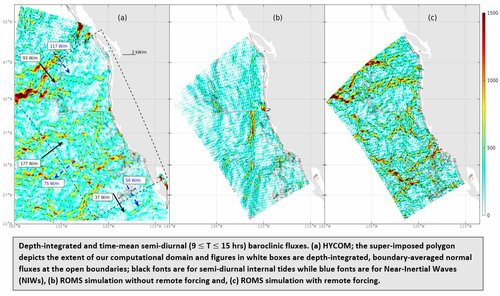Abstract's details
Impact of Remote Internal Waves on Internal Wave Energetics of Regional Model Simulations
CoAuthors
Event: 2022 Ocean Surface Topography Science Team Meeting
Session: Tides, internal tides and high-frequency processes
Presentation type: Type Forum only
Contribution: not provided
Abstract:
In this study, we demonstrate that remote internal waves are important for the local energetics in regional ocean circulation models. In addition to mesoscale forcing, we force 4-km Regional Ocean Modelling System (ROMS) simulations of the U.S. West Coast with surface tides and internal waves from an 8-km Hybrid Coordinate Ocean Model (HYCOM) simulation. We evaluate the regional model’s boundary conditions for reflections, we validate our simulations with observations, and we study internal wave energetics (IWEs).
To control the reflections of internal waves generated in the interior of the domain, we include sponge layers at the open boundaries. We quantify reflection estimates with the help of a discrete Fourier transform (DFT) technique. We use the DFT technique in separating ingoing and outgoing waves at the open boundaries. We find that a sponge width and viscosity of 58 km and 800 m^2/s are optimal for our domain.
We validate our simulations using a 17-years long altimeter dataset and a historic mooring database. To ensure apples to apples comparison, we apply a spatially varying correction factor to obtain stationary equilibrium amplitudes for our one-year simulations. With remote forcing at the open boundaries, the coefficient of determination (R^2) for M2 SSH amplitude increases from 65.5% (for no remote internal tides case) to 85.1% when compared to altimetry. We also obtain approximately 35% increase in root mean square amplitude (RMSA). Across all frequency bands, the velocity and temperature variance captured also increases due to remote internal waves forcing when compared to a historical mooring dataset.
We also show in this study that it may be insufficient to force regional ocean circulation models at their lateral boundaries with only stationary internal tides (ITs). We estimate depth integrated and time mean stationary baroclinic fluxes at the western boundary of our domain to be 34.5% of the total semi-diurnal internal tide fluxes generated from the Hawaiian Island Ridge, i.e., 75.5% is nonstationary. In addition, we find that near-inertial waves (NIWs) constitute a significant portion of the remotely generated internal waves at the open boundaries; for instance, NIWs make up approximately 56% of the total remote baroclinic fluxes at the Northern boundary. We plan to evaluate IWEs in the interior of our domain when the model is forced with stationary, total ITs and total ITs + NIWs at the open boundaries. We also intend to study how seasonal variability in our remote forcing affect our domain’s IWEs.
To control the reflections of internal waves generated in the interior of the domain, we include sponge layers at the open boundaries. We quantify reflection estimates with the help of a discrete Fourier transform (DFT) technique. We use the DFT technique in separating ingoing and outgoing waves at the open boundaries. We find that a sponge width and viscosity of 58 km and 800 m^2/s are optimal for our domain.
We validate our simulations using a 17-years long altimeter dataset and a historic mooring database. To ensure apples to apples comparison, we apply a spatially varying correction factor to obtain stationary equilibrium amplitudes for our one-year simulations. With remote forcing at the open boundaries, the coefficient of determination (R^2) for M2 SSH amplitude increases from 65.5% (for no remote internal tides case) to 85.1% when compared to altimetry. We also obtain approximately 35% increase in root mean square amplitude (RMSA). Across all frequency bands, the velocity and temperature variance captured also increases due to remote internal waves forcing when compared to a historical mooring dataset.
We also show in this study that it may be insufficient to force regional ocean circulation models at their lateral boundaries with only stationary internal tides (ITs). We estimate depth integrated and time mean stationary baroclinic fluxes at the western boundary of our domain to be 34.5% of the total semi-diurnal internal tide fluxes generated from the Hawaiian Island Ridge, i.e., 75.5% is nonstationary. In addition, we find that near-inertial waves (NIWs) constitute a significant portion of the remotely generated internal waves at the open boundaries; for instance, NIWs make up approximately 56% of the total remote baroclinic fluxes at the Northern boundary. We plan to evaluate IWEs in the interior of our domain when the model is forced with stationary, total ITs and total ITs + NIWs at the open boundaries. We also intend to study how seasonal variability in our remote forcing affect our domain’s IWEs.
